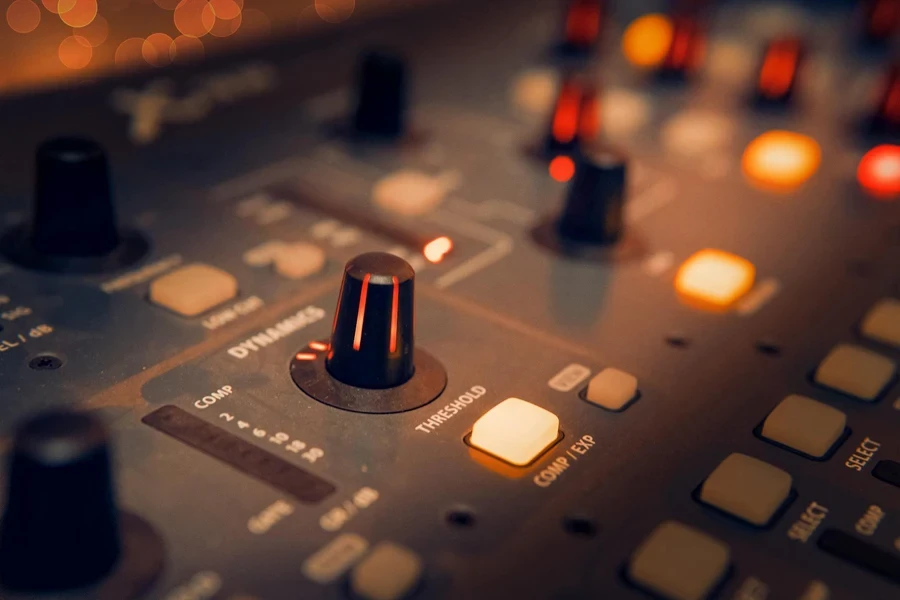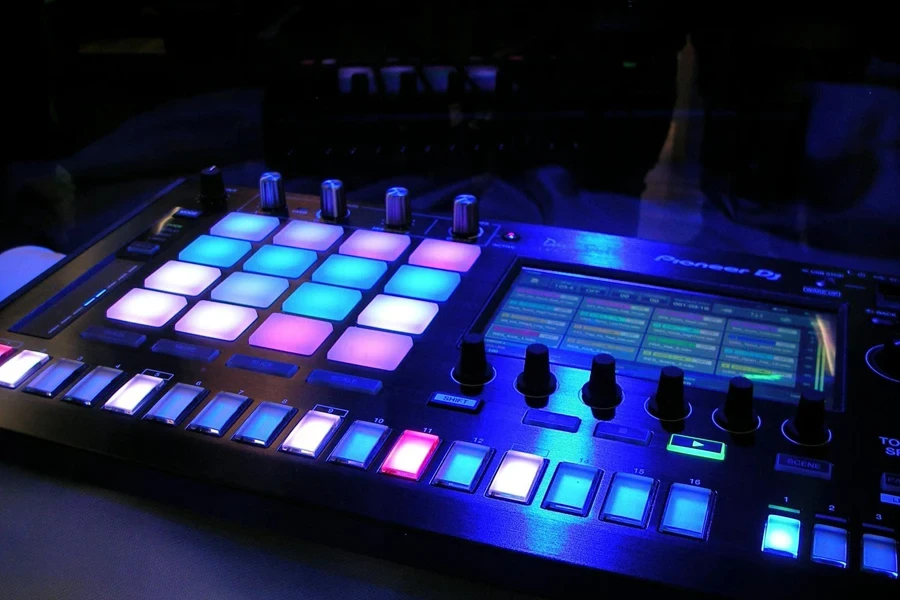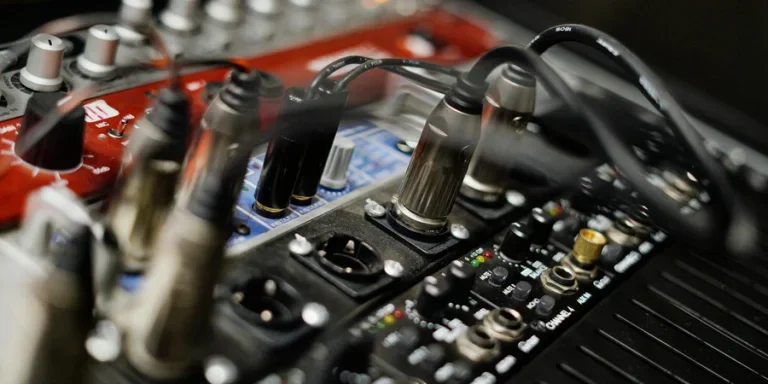Table of Contents
● Introduction
● Market overview
● Different types and their features
● Things to consider when selecting products
● Conclusion
Introduction

Audio mixers play a pivotal role in modern audio production, significantly enhancing sound quality for studios, live performances, and home setups. The market for these essential tools is expanding rapidly, driven by the increasing demand for good quality audio in various applications. Advanced features in digital and hybrid mixers cater to the needs of professionals seeking precision and versatility. Understanding the different types and their features is crucial for selecting the right equipment. This article delves into the market trends, types, and key considerations for choosing the ideal audio mixers.
Market overview

Market scale and growth
The audio mixing console market reached a value of USD 393.4 million in 2022 and is projected to grow at a compound annual growth rate (CAGR) of over 4.5% from 2023 to 2032, potentially reaching USD 615.7 million by 2032. This growth is primarily driven by the increasing demand for live music events, home studios, the integration of networked audio systems, and the expansion of streaming and online content creation. Additionally, advancements in digital technology and AI integration in mixing consoles are propelling market expansion.
Regional insights
Asia Pacific holds a dominant position in the market, accounting for over 35% of the market share in 2022. This dominance is attributed to the region’s robust music industry, extensive entertainment sectors, and high adoption of advanced technologies. Countries like China, Japan, and India are major contributors, with a high number of live music events, recording studios, and broadcasting facilities driving the demand for sophisticated audio mixing consoles. The continuous investment in cultural events and live performances further fuels market growth in this region.
Different types and their features

Analog mixers
Analog mixers are prized for their warm, natural sound, making them a staple in both live sound and recording environments. These mixers employ analog circuits to process audio signals, ensuring minimal latency and real-time control. Key features include tactile controls such as rotary knobs and faders, which provide immediate, hands-on manipulation of audio levels. Analog mixers often come with multiple auxiliary sends and returns, allowing for intricate routing of external effects. They typically support a range of input types, including XLR and 1/4″ TRS, and offer built-in preamps with phantom power for condenser microphones. Analog mixers also provide parametric EQ controls on each channel, enabling precise tonal adjustments.
Digital mixers
Digital mixers are equipped with powerful DSP (Digital Signal Processing) engines that offer a multitude of features such as dynamic range compression, gating, and advanced equalization. These mixers allow for precise control over audio parameters and include functionalities like scene recall, which saves and retrieves entire setup configurations. Digital mixers support extensive connectivity options, including USB, Ethernet, and Dante networking for seamless integration with digital audio networks. Many models feature touchscreens for intuitive navigation and control, and they often include remote mixing capabilities via tablets or smartphones. Digital mixers can handle a high number of input channels, often exceeding 32, and provide comprehensive metering and monitoring tools.
Powered mixers
Powered mixers combine the functionality of a mixer and a power amplifier in a single unit, offering convenience and portability. These mixers are designed to deliver sufficient wattage to drive passive PA speakers directly, often featuring built-in amplifiers with power outputs ranging from 300 to 1000 watts per channel. Key technical features include multiple input channels with mic preamps, built-in digital effects processors (such as reverb, delay, and chorus), and feedback suppression algorithms. Powered mixers usually have a robust metal chassis for durability and come with cooling fans to prevent overheating during prolonged use. They offer line-level outputs for connecting to additional powered speakers or external amplifiers.
Hybrid mixers
Hybrid mixers merge the best of analog and digital technologies, providing the warmth of analog audio circuits with the flexibility and precision of digital processing. These mixers feature analog signal paths with good quality AD/DA converters that digitize the audio for further manipulation within the digital domain. Hybrid mixers often include digital effects, recallable scenes, and MIDI control, enabling integration with other digital equipment. They provide multiple analog inputs and outputs, as well as digital I/O options like USB and AES/EBU. Hybrid mixers typically have a robust build with a combination of traditional rotary knobs and digital touchscreens for versatile control.
Other types
Rack-mount mixers
Designed for fixed installations or portable racks, these mixers save space and offer extensive I/O options for complex setups.
Portable mixers
Compact and lightweight, suitable for on-the-go applications such as field recording and small live gigs. They often feature battery operation and robust construction.
In-line mixers
Used primarily in broadcasting and live sound, these mixers can be integrated directly into an audio signal path, offering real-time mixing capabilities without the need for external processing.
Mixing consoles
Large-format mixers designed for professional studios and live sound applications, featuring multiple channels (often 48 or more), extensive routing options, and advanced automation capabilities. These consoles provide detailed metering, high-resolution faders, and comprehensive monitoring sections for precise audio control.
Things to consider when selecting products

Number of channels
When selecting an audio mixer, the number of channels is crucial for accommodating all audio sources such as microphones, instruments, and playback devices. A typical small band setup might require at least 16 channels to cover multiple vocals, guitars, bass, and drums, while larger setups, like orchestras or multi-track recording studios, may need 32 channels or more. Some mixers also offer expandable channel options through digital stage boxes, allowing for future growth without replacing the entire mixer.
Type of mixer
Choosing the right type of mixer depends on specific needs. Analog mixers are appreciated for their straightforward operation and natural sound, often featuring high-quality preamps and analog circuitry that deliver low-noise audio performance. Digital mixers offer advanced capabilities like multi-track recording via USB or SD card slots, integrated DSP for onboard effects, and wireless control through apps on tablets or smartphones. Powered mixers combine a mixer with a built-in amplifier, typically offering outputs in the range of 300 to 1000 watts per channel, making them ideal for portable PA systems. Hybrid mixers blend the tactile feel of analog with the flexibility of digital, featuring analog signal paths with digital control and recallable settings.
Key features
Essential features to look for in a mixer include:
EQ controls
Parametric EQs allow precise frequency adjustments, often with multiple bands per channel, including sweepable mids and fixed low/high frequencies.
Auxiliary buses
These provide additional routing options for monitors and external effects, with pre-fader and post-fader sends for flexible signal control.
Onboard effects
Look for high-quality digital effects like reverb, delay, and compression with adjustable parameters and the ability to store presets.
USB outputs
Facilitate multi-track recording directly to a computer or DAW, supporting sample rates up to 96 kHz for high-resolution audio.
Remote control
Wireless control via Wi-Fi or Bluetooth allows real-time adjustments from anywhere in the venue, essential for live sound engineers.
Connectivity and compatibility
Ensure the mixer is compatible with the existing equipment and future needs. This includes having a variety of input and output connectors, such as balanced XLR and TRS for mic and line inputs, RCA for consumer audio sources, and digital I/O options like ADAT, AES/EBU, or Dante for networked audio. Additionally, check for MIDI connections if integration with other MIDI-compatible gear is required. The mixer should also support seamless integration with PA systems, recording interfaces, and other outboard gear.
Size and portability
Consider the physical size and portability of the mixer. Fixed installations can benefit from larger, full-featured consoles with extensive routing and control options. Portable mixers, often rack-mountable or with built-in carrying handles, are designed for easy transport and quick setup. Some portable mixers are powered by batteries, making them ideal for field recording or remote broadcasts. Ensure the mixer’s size and weight fit the intended use case without compromising on necessary features.
Budget and quality
Balancing cost and quality is essential. High-end mixers feature superior build quality, rugged enclosures, and high-fidelity audio components such as low-noise preamps and high-resolution converters. However, even budget-friendly mixers can offer substantial functionality with modern DSP, multi-effects, and versatile connectivity. Researching product reviews and user experiences can provide insight into reliability and performance, helping to identify mixers that offer value for money.
Support and warranty
Reliable support and a comprehensive warranty are vital for professional users. Look for mixers that come with at least a one-year warranty, covering parts and labor. Extended warranties and service plans can provide additional peace of mind. Manufacturers that offer extensive online resources, including manuals, firmware updates, and tutorial videos, can enhance the user experience. Responsive customer support, accessible through multiple channels such as phone, email, and live chat, ensures that technical issues are resolved promptly, minimizing downtime.
Conclusion

Audio mixers are essential components for achieving good quality audio production. By understanding current market trends, the various types of mixers available, and their key features, businesses can make informed decisions to select the most suitable products for their specific needs. This ensures optimal performance and superior sound quality in professional audio environments.




